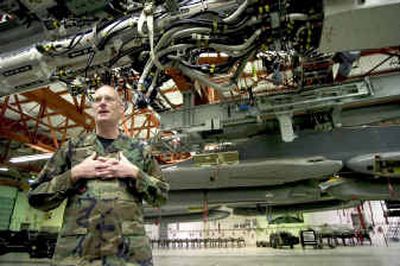Fairchild squadron on cruise control

Nearly all of the air-launched cruise missiles used to help shock and awe Iraq at the beginning of the war were checked out at Fairchild Air Force Base first.
Keeping the missiles in working order is the job of the Air Combat Command’s 2nd Support Squadron, said Maj. David Miller, who took reporters and photographers on a tour of his squadron’s storage and maintenance facilities at the base Monday.
That the weapon designed in the late 1970s could be used with such effectiveness nearly 25 years after it was built is a source of pride for the squadron’s 104 men and women stationed in Spokane. After all, the cruise missile, with a range of more than 1,500 nautical miles, can hit within two feet of a target.
“It was nice to see something I worked on actually being used,” said Tech. Sgt. Ross Saltzman, who used to work on intercontinental ballistic missiles at Grand Forks Air Force Base in North Dakota before being transferred to the 2nd Support Squadron.
All of the missiles currently at Fairchild were built by Boeing Defense and Space Group in the early 1980s. They have to be inspected every two years by technicians like Saltzman, using a computer the size of a refrigerator with Boeing software as old as the missile itself. The number of missiles at Fairchild is classified.
To be able to work on the cruise missile global positioning and navigation systems requires nearly eight months of training.
The AGM-86 comes in two basic models. The ALCM, or air-launched cruise missile, was designed to carry a nuclear warhead, but can be converted to carry a conventional payload. The CALCM, or conventional air-launched cruise missile, comes with a conventional explosive payload. Both models come in gray only and cost upward of $1 million each.
“When you care enough to send the very best” is the unofficial motto inscribed on the 2nd Support Squadron commemorative coin.
The missile is 20 feet, 9 inches long and weighs 3,150 pounds. It is 24.5 inches in diameter and has a wingspan, when the wings are deployed during flight, of 12 feet.
Unlike the Navy’s Tomahawk sea-launched cruise missile, the ALCM and the CALCM can only be launched from the air by the B-52H bomber. Each bomber can carry 20 missiles. Two pylons attached below the B-52’s wings carry six missiles each. Another eight missiles are transported inside the plane on a rotary launcher – like the cylinder of a revolver – that can fire all eight in less than a minute.
The missiles pack either a 2,000-pound or 3,000-pound payload. The latest incarnation of the CALCM, the AGM-86D, is designed to penetrate hardened targets, like Saddam Hussein’s underground bunkers, before exploding.
Besides Iraqi Freedom, the missile has been used in operations Desert Storm in January 1991, Desert Fox in 1998 and Allied Force (Kosovo) in 1999.
Some of the airmen who work on the missiles said they were eager to get off work the day the United States began using the missiles in Iraqi Freedom so they could watch the results of their hard work on television. But Master Sgt. Peter Whittlesey, the squadron’s flight chief, had mixed feelings.
“It never feels good” to see people dying, he said. “But you think, ‘That is what you spent your life working on, and you know you did your job right.’ “